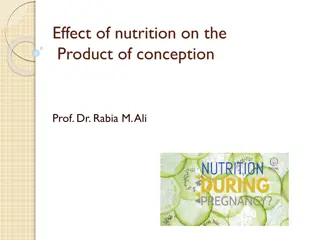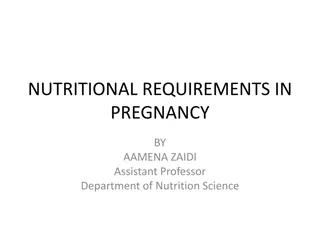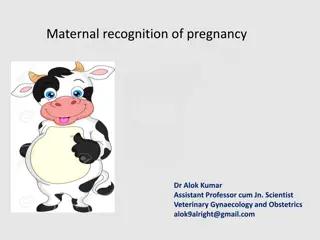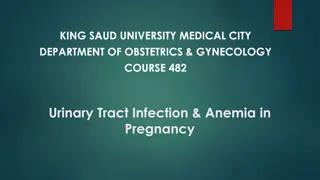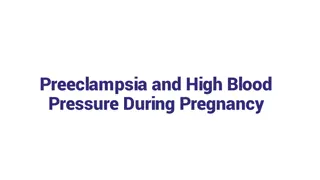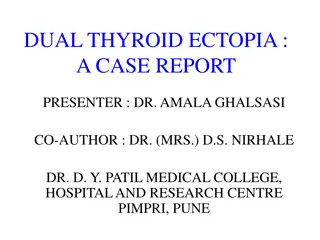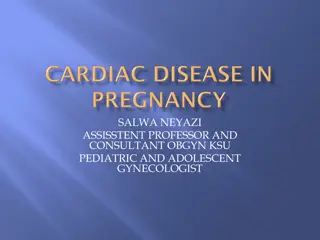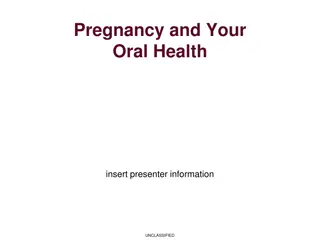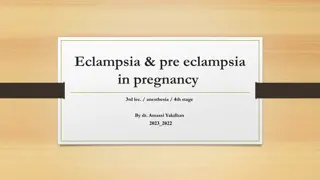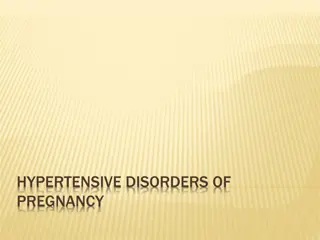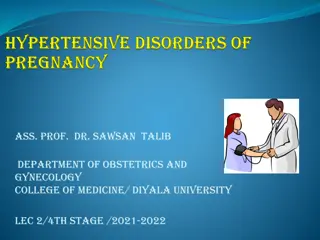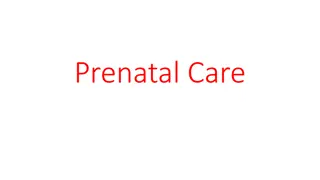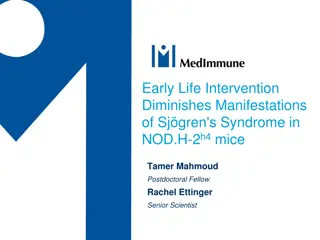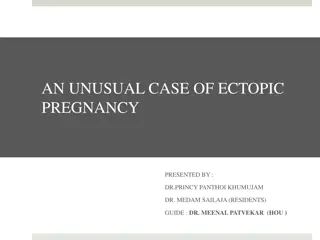Understanding Ectopic Pregnancy: Causes, Risks, and Management
Ectopic pregnancy occurs when the fertilized egg implants outside the uterus, most commonly in the fallopian tubes. This abnormal implantation can lead to serious complications, including maternal mortality. Risk factors include previous ectopic pregnancy, tubal surgery, and maternal age. Recognizing the signs and managing ectopic pregnancies promptly is crucial for a positive outcome.
Download Presentation

Please find below an Image/Link to download the presentation.
The content on the website is provided AS IS for your information and personal use only. It may not be sold, licensed, or shared on other websites without obtaining consent from the author. Download presentation by click this link. If you encounter any issues during the download, it is possible that the publisher has removed the file from their server.
E N D
Presentation Transcript
Introduction: The blastocyst normally implants in the endometrial lining of the uterine cavity. Implantation anywhere else is considered an ectopic pregnancy. It is derived from the Greek ektopos out of place . Incidence:- According to the American College of Obstetricians and Gynecologists (2008), 2 % of all first-trimester pregnancies in the United States are ectopic, and these account for 6 % of all pregnancy-related deaths.
Incidence One in account Western countries. The incidence pregnancy is intrauterine & other is extrauterine ) in population is low (1:25,000 30,000), higher after in-vitro (1%) due to and aetiology pregnancies are 9 13% of world and 10 30% in 80 for ectopic. They maternal deaths in the low resource of a heterotopic pregnancy (one the general but significantly (IVF) treatment two blastocysts. fertilization the transfer of
Classification Nearly 95 % of ectopic pregnancies are implanted in the various segments of the fallopian tubes .Of these, most are ampullary implantations. The remaining 5 % implant in the ovary, peritoneal cavity, or within the cervix.
Tubal Pregnancy The fertilized ovum may lodge in any portion of the oviduct, giving rise to ampullary, isthmic, and interstitial tubal pregnancies). In rare instances, the fertilized ovum may implant in the fimbriated extremity. The ampulla is the most frequent site, followed by the isthmus. accounts for only About 2%.From these primary types, secondary forms of tubo-abdominal, tubo- ovarian, and pregnancies occasionally develop. Interstitial pregnancy
Risk Factors 1-previous ectopic pregnancy 3-13% 2-Tubal corrective surgery 4% 3-Tubal sterilization 9% 4-Intrauterine device 1-4% 5-Documented tubal pathology 3.8 21% 6-Infertility 2.5 3% 7-Assisted reproductive technolog y 2 8% 8-Previous genital infection 2 4 % Chlamydia 2% Salpingitis 1.5 6.2%
9-Smoking 1.74% 10-Multiple sexual partners 1.6 3.5% 11-Prior cesarean delivery 1 2.1% 12-Maternal age (peak 25 to 34 years). Recurrence rate is about 10-15%
Pathophysiology: In theory, any mechanical or functional factors that prevent or interfere with the passage of the fertilized egg to the uterine cavity may be etiological factor for an ectopic pregnancy. In general the main cause is a low grade infection- chronic PID. In an ectopic pregnancy, the uterine endometrium usually responds to the hormonal changes of pregnancy & undergoes focal decidual
Natural history of untreated tubal pregnancy: The most common outcomes of established tubal pregnancies include the following: 1.Tubal rupture. 2.Pregnancy resorption. 3.Tubal abortion into the peritoneal cavity. Clinical presentation: a.Acute presentation (tubal rupture): 1.Acute abdominal pain referred to the shoulder tip. 2.Cardiovascular collapse. 3.Normal temperature. 4.Uterus slightly enlarged & there is a tender mass to one side. 5.Positive cervical excitation.
b. Subacute presentation: Give rise to diagnostic confusion. 1.Abdominal pain which can be localized to one iliac fossa. 2.Delayed menstruation. 3.Episodes of vaginal bleeding. 4.There may be referred pain to shoulder. 5.Abdominal & pelvic examination reveal sign of peritoneal irritation less marked than in an acute situation. c. Asymptomatic (silent presentation). :discovered during assessment of early pregnancy or while investigating for other complain
Diagnosis: Symptoms of ectopic pregnancy tend to have a poor positive predictive value to help discriminate between intra & extra uterine pregnancy. They may present as acute/ subacute or silent presentation. Signs: often have no specific signs: 1.Rapid heart rate, low BP may be noticed. 2.peritonism (due to intra abdominal blood if ruptured). 3.Gynecological examination: speculum or bimanual examination must be performed in an environment where facilities for resuscitation are available because may provoke tubal rupture.
uterus usually normal size. cervical excitation & tenderness occasionally. adnexial tenderness. adnexial mass. Investigation: I.Ultrasound: transvaginal U/S : gestational sac of an intra uterine pregnancy should be detectable when serum B-hCG level exceeds 1000IU/L. The presence or absence of an intra uterine gestational sac is the principle point of distinction between intra uterine and tubal pregnancy. Morphology of ectopic pregnancy can be classified by U/S into 5 categories: 1.Gestational sac with a live embryo. 2.Sac with an embryo but no heart rate. 3.Sac containing yolk sac. 4.Empty gestational sac. 5.Solid tubal swelling
The presence of fluid in the pouch of Douglas is a non specific sign of ectopic pregnancy. In 10 to 20% of ectopic pregnancy a pseudo gestational sac is seen as a small, central located endometrial fluid collection surrounded by a single echogenic rim of endometrial tissue undergoing decidual reaction. II. Biochemical measurements: 1.Serum hCG: Healthy normally developing pregnancies generally can be detected by a normal rate of increase of maternal serum B-hCG levels.
Normal pregnancies show doubling of hCG levels every 48 hours in the first few weeks of pregnancy & sub optimal rise is suspicious of an ectopic pregnancy i.e. a prolonged hCG doubling time is an indicator of an abnormal pregnancy. 2. Serum progesterone: Serum progesterone levels will respond quickly to any decrease in hCG production. Serum progsterone <20 nmol/L reflects fast decreasing hCG levels and can be used to diagnose spontaneous resolving pregnancies. Progesterone level >60 nmol/L indicate normal increase in hCG level but those between 20 & 60 nmol/L are strongly associated with abnormal pregnancy
Culdocentesis This simple technique was used commonly in the past to identify hemoperitoneum. The cervix is pulled toward the symphysis with a tenaculum, and a long detresni hguorht otni eht luc - ed - cas . fI ,tneserp diulf eruliaf ot od os si deterpretni ylno sa - ed - cas dna seod ton edulcxe na derutpur ro derutpurnu . diulF ,stolc ro ydoolb diulf taht seod ton sisongaid fo muenotirepomeh gnitluser eht doolb yltneuqesbus ,stolc ti yam tnecajda doolb lessev rehtar naht morf a gnideelb cipotce ycnangerp eldeen lanigav ,revewoh otni eht rehtie stnemgarf fo dlo htiw eht ycnangerp . fI morf na si eguag - 18 ro 16 eht nac - xinrof roiretsop ,detaripsa yrotcafsitasnu yrtne ,ycnangerp gniniatnoc elbitapmoc cipotce deniatbo eb luc cipotce si ,tolc morf evah na neeb
Multimodality Diagnosis: Ectopic pregnancies are identified with the combined use of clinical findings along with serum analyte testing and transvaginal sonography. A number of algorithms have been proposed, but most include five key components: 1.Transvaginal sonography 2.Serum hCG level both the initial level and the pattern of subsequent rise or decline 3.Serum progesterone level 4.Uterine curettage 5.Laparoscopy and occasionally, laparotomy.
Management In many cases, early diagnosis allows definitive surgical or medical management of unruptured ectopic pregnancy sometimes even before the onset of symptoms. In either case, treatment before rupture is associated with less morbidity and mortality and a better prognosis for fertility. D-negative women with an ectopic pregnancy who are not sensitized to D-antigen should be given anti-D immunoglobulin Surgical Management Laparoscopy is the preferred surgical treatment for ectopic pregnancy unless the woman is hemodynamically unstable .
The laparoscopy. compromised facilities. Fallopian or made extracted is recommended only absent or with a higher rate subsequently normal because the ipsilateral standard surgical treatment Laparotomy patients or The operation tube and some cases the site via this if visibly damaged, of remain high oocyte can or contralateral approach is is where there reserved for severely are of choice is removal of the EP within (salpingectomy), small opening can the EP and opening ( salpingostomy). Salpingostomy the contralateral and it subsequent EP. if the contralateral be picked up tube. no endoscopic the a of in over be the EP tube is associated Pregnancy rates is tube is by the
Tubal surgery is considered conservative when there is tubal salvage. Examples include salpingostomy, salpingotomy, and fimbrial expression of the ectopic pregnancy . Radical surgery is defined by salpingectomy. Conservative surgery may increase the rate of subsequent uterine pregnancy but is associated with higher rates of persistently functioning trophoblast. Salpingostomy This procedure is used to remove a small pregnancy that is usually less than 2 cm in length and located in the distal third of the fallopian tube .A htiw edam si noisicni raenil mm eht revo redrob ciretnesemitna eht no yretuac eldeen ralopinu noisicni eht morf edurtxe lliw yllausu stcudorp ehT .ycnangerp hgih gnisu tuo dehsulf ro devomer ylluferac eb nac dna - erusserp eussit citsalbohport eht sevomer ylhguoroht erom taht noitagirri - 15 ot - 10
.Small electrocoagulation or laser, and the incision is left unsutured to heal by secondary intention,it is used if other tube is not healhty or absent Salpingotomy Seldom performed today, salpingotomy is essentially the same procedure as salpingostomy except that the incision is closed with delayed-absorbable suture. Salpingectomy Tubal resection may be used for both ruptured and unruptured ectopic pregnancies. When removing the oviduct, it is advisable to excise a wedge of the outer third (or less) of the interstitial portion of the tube. This so-called cornual resection is done in an effort to minimize the rare recurrence of pregnancy in the tubal stump. Even with cornual resection, however, a subsequent interstitial pregnancy is not always prevented bleeding sites are controlled with needlepoint
Medical management Intramuscular methotrexate is a option for patients with minimal symptoms, an adnexal mass <40 mm in diameter and a serum hCG concentration 3,000 IU/l. treatment current under
Methotrexate is inhibits particularly of methotrexate is patient s mg/m2. is usually 4, 7 undetectable (levels need to between day fall with treatment). therefore only present for acid antagonist acid (DNA) synthesis, trophoblastic cells. The calculated based on body surface area After methotrexate treatment routinely measured and 11, then weekly thereafter fall 4 and 7, Medical be offered if regular follow up a folic that deoxyribonucleic affecting dose the 50 and is serum hCG on days until by and treatment should facilities are visits. 15% continue to
The (1) chronic (2) active infection; (3) immunodeficiency; (4) breastfeeding. (5) Fetal cardiac activity. this is a relative contraindication to medical therapy few treatment contraindications include: liver, renal or haematological to medical disorder; and
There are also known side-effects such as stomatitis, conjunctivitis, gastrointestinal skin reaction, and about two-thirds suffer from non-specific abdominal pain. important to advise intercourse during treatment conceiving for 3 months because of the also important to alcohol and prolonged during treatment. upset and photosensitive of patients will It is women to avoid sexual to and avoid treatment after methotrexate risk of teratogenicity. advise them to exposure It is avoid to sunlight
Patient Selection The best candidate for medical therapy is the woman who is asymptomatic, motivated, and compliant. With medical therapy, some classical predictors of success include: 1.Initial serum hCG level . 2.Ectopic pregnancy size .. A 93% success rate with single dose methottexate when the ectopic mass was < 3.5 cm ,
Expectant Management In select cases, it is reasonable to observe very early tubal pregnancies . Expectant management is that a significant proportion resolve without any treatment. Expectant women with these criteria: 1.Tubal ectopic pregnancies only 2.Decreasing serial hCG levels 3.Diameter of the ectopic mass not <or=3.5 cm 4.No evidence of intra-abdominal bleeding or rupture by transvaginal sonography. based on of management the assumption all Eps will is indicated So,. haemodynamically so). The levels are undetectable. With expectant management, subsequent rates of tubal patency and intrauterine pregnancy are comparable management. This option is suitable for and asymptomatic hCG patients who are remain until stable (and patient requires serial measurements with surgery and medical
Increasing Ectopic Pregnancy Rates A number of reasons at least partially explain the increased rate of ectopic pregnancies in the United States and many European countries. Some of these include: 1-Increasing prevalence of sexually transmitted infections, especially those caused by Chlamydia trachomatis 2-Identification through earlier diagnosis of some ectopic pregnancies otherwise destined to resorb spontaneously 3-Popularity of contraception that predisposes pregnancy failures to be ectopic 4-Tubal sterilization techniques that with contraceptive failure increase the likelihood of ectopic pregnancy 5-Assisted reproductive technology 6-Tubal surgery, including salpingotomy for tubal pregnancy and tuboplasty for infertility
Differential diagnosis of ectopic pregnancy: Gynecologic problems: Threatened or incomplete abortion. Ruptured corpus luteum cyst. Acute PID. Adnexal torsion. Degenerating leiomyoma (especially in pregnancy). Non- gynecologic problems: Acute appendicitis. Pyelonephritis. Pancreatitis.





